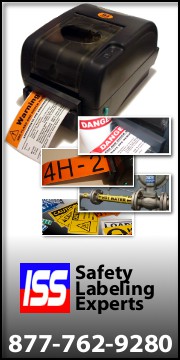Labeling FAQs
This page has the answers to your labeling questions. Please browse the faqs below for answers to all of your questions on safety labeling.
Question: What is safety labeling about?
Answer: In almost any industry, in almost any country or government, safety labeling is required for the well-being of workers, visitors or customers. Many times, a regulatory body is established to deal with safety concerns, including safety labeling. In many parts of the world, ANSI standards are used for safety labeling. OSHA is another example of a governing body that deals with safety labeling.
Question: What OSHA and ANSI requirements relate to labeling?
Answer: OSHA section 1910 and ANSI z535 relate to labeling. For example, OSHA 1910.144 is the "Safety color code for marking physical hazards" section, and can help you understand how you need to label for maximum visibility and efficacy. Depending on your company, you may or may not need to worry about strict adherance to OSHA and ANSI standards, but it is never a bad idea to use standards-based methods for labeling.
Question: What is NFPA and RTK?
Answer: NFPA stands for "National Fire Protection Agency," and RTK stands for "RIGHT TO KNOW." Both acronyms relate to chemical labeling, and most specifically for fire safety. NFPA and RTK labeling has come to mean more than just fire safety in chemical labeling, many companies rely on NFPA RTK labels for quick hazard identification. To properly label for NFPA RTK, you need a multi-color label, which can have pre-printed colors for a more cost effective multi-color solution.
Question: Do I need to worry about general safety labeling?
Answer: Many companies wonder if they need to worry about general safety labeling, or safety labeling that isn't related to a specific standard or requirement. Workplace safety is a #1 concern, and reducing hazard risks can be one way to increase productivity. By properly labeling hazards, companies can reduce risk and accidents, saving time, money and lives. By using a consistent approach to visual awareness, you can take general safety labeling to a whole new level, and produce results that are measurable and meaningful.
Question: What kind of labeling supplies are the best?
Answer: It is important to use labeling supplies that will be highly visible, and that will hold up in your particular application. Some of the most durable labeling supplies on the market are poly or vinyl based, and have inks that are designed to be UV, chemical and scratch resistant. Avoid paper supplies or cheap synthetics that just aren't designed for safety labeling. Always ask how a particular supply will hold up in your environment.
Question: Supplies can be expensive, how can I save some money?
Answer: Remember, your goal is safety, and getting the right supplies up-front will save you more in the long-run. Quality labeling supplies will cost more, because you are paying for quality adhesives, poly and vinyls that are formulated to last for years. You could spend less, but cheaper materials will fade, scratch and fall off over time, costing you more in re-labeling projects and in reduced safety.
Question: How can I spot cheap supplies?
Answer: It can be hard to tell the difference between cheap and quality supplies at first glance. Always obtain samples of the supplies that you are looking to purchase; companies that don't provide samples likely aren't selling you top-grade materials. Avoid paper-like materials that rip easily. Avoid labeling materials that are excessively thin, or feel flimsy. Always ask for a "spec sheet" to find out how a material is rated. Finally, if it seems to cheap to be good, it just might be- shop around for a company that can stand behind its product.
